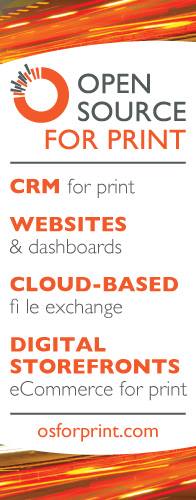Data-driven customer relationships are here to stay
By Charles Groce, CEO of Pearl Street Consulting
Republished from Graphic News magazine, August 2015
Establishing strong one-on-one relationships with customers has been good for business since people first started buying things they no longer wanted to or could produce themselves. No one in their right mind would ever claim that its a bad idea to get to know customers and their needs.
But the days where this is enough are long gone. Everyone knows price is king, especially in print, and as a customer being able to trust your reputation with your printing partner is a close second. This is why its imperative for businesses of all kinds to be on top of their customers needs and to know their work intimately. This begs the question: How can printing shops with dozens, hundreds, or even thousands of customers do that effectively and convincingly with limited staff and resources?
The answer is with technology. If you’ve read my previous articles you know how I feel about manila envelopes full of customer information stacked on the top of desks of over-worked customer service reps. You can’t “Google search” a stack of manila envelopes. You can’t automate tasks and reminders based on sticky notes tacked to monitors locked behind office doors.
What happens if a key customer service rep gets sick and know one knows to send key documentation required by the purchaser within 24 hours of shipping? I’ll tell you what happens, the customer relationship suffers. Competitors who have been emphasizing the quality of their customer service get a new opportunity to pitch, and an important account may be lost.
Having friendly and likeable customer service and sales reps today, in this economy, is not enough to keep long term customer relationships alive. For this same reason, main street groceries are a thing of the long ago past. Price is indeed king.
The right strategy in mitigating relationship straining situations, which happen in every business, is to take an internally transparent and systematic approach to resolving the inefficiencies in the handling and organizing of customer-specific information. What does this mean?
First and foremost it means the establishing a good documentation system not based on stacks of manila envelopes and sticky notes. Second it means doing away with the old network folder based storage of customer information. (You know the system, where staff has to remember WHERE critical information is stored on the network. Aren’t computers better at remembering where things are stored?).
Instead deploy a smart documentation system which is easy to understand and to use. Every good documentation system comes with a powerful search engine, and with it you can have an intuitive, search engine internal to your company network ready to handle questions from staff in virtually any format, and ready to assist sales and customer service reps in satisfying customer needs in mere seconds.
Like most major technology solutions, there are a variety of open source solutions available to assist you in the organization of key operational and customer data. The two that come to my mind immediately are MediaWiki and SugarCRM.
MediaWiki is the same platform that powers Wikipedia, the 5th most visited website in the world, and is a web-based, fully open source documentation/web publishing system. MediaWiki is supported by thousands of developers and hundreds of plugins. If you think of a feature you want in your documentation system down the road, chances are someone else in the global business community has already thought of it and an open source developer has already written a plugin for it for one of the open source systems. The same is true for virtually all prominent open source software systems and is why I prefer to deploy them. Why waste time reinventing the wheel, or worse, paying someone else to reinvent the wheel?
Not all business is appropriate for an everyone-has-access documentation system. Customer-specific or customer-required information is better stored in a CRM (Customer Relationship Management system), which allows you to organize data around your accounts and customer contacts, and to unify these efforts with marketing initiatives. CRM’s also come with a powerful search engine, so finding information is quick and easy. Like the documentation system, very powerful open source solutions exist which in many cases exceed the proprietary and expensive alternatives in terms of functionality and flexibility.
Integrating these systems with mission critical systems such as an MIS (Management Information System) and connecting them to your customer-facing portal or website is how you truly tie the knot in unifying a customer-oriented approach to customer and operational data. The integration of core systems does not have to cost an arm and a leg when you’re not reinventing the wheel.
So throw away (or better yet recycle!) those manila envelopes. The ability of companies to effectively organize information is sure to be a continual market differentiator and for this reason is here to stay. Manila envelopes are not.

